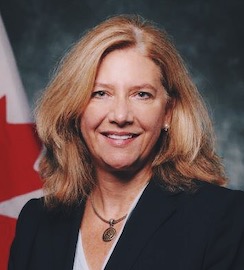Interview with RAdm Jeff Zwick, Chief of SSE Combat Systems Integration, Canadian Armed Forces and Christiana Cavazzoni, Associate Assistant Deputy Minister, Information Management, and Deputy Chief Information Officer, Department of National Defence.
The Canadian Armed Forces and Department of National Defence are embarking on a digital journey that will provide Canada and Canadian sailors, soldiers, aviators, and Special Forces operators with opportunities to ensure that they have the capabilities required to succeed in the battlespace alongside our partners and allies today and into the future.

Vanguard recently had the opportunity to connect with RAdm Jeff Zwick, Chief of SSE Combat Systems Integration, Canadian Armed Forces, and Christiana Cavazzoni, Associate Assistant Deputy Minister, Information Management, and Deputy Chief Information Officer, Department of National Defence about this digital journey. Both have played an integral part in C4ISR and Beyond, a conference hosted by Vanguard, that brings stakeholders from industry, military, and government to discuss C4ISR lessons learned, share its technological advancement and impact within defence.
In their latest presentations at C4ISR and Beyond 2021, RAdm Zwick and Ms. Cavazzoni delved into digital as being the core of C4ISR and delivering digital through partnerships respectively. To carry on the conversation, we are delighted to present a round table discussion with these two prominent digital leaders within military and government.
To begin, please provide an overview of your respective roles and responsibilities.
RAdm Jeff Zwick: As Chief of Combat Systems Integration, on behalf of the Vice Chief of the Defence Staff, I am charged with taking a holistic view of our overall capabilities while focusing on Joint and Pan-Domain capabilities, such as C4ISR, and with aligning some key initiatives, including digitalization.
Christiana Cavazzoni: As Associate ADM IM and deputy CIO, and on behalf of the CIO Len Bastien, I am responsible for the transformation of the IM/IT functions that are pivotal to the DND/CAF digital agenda. My focus is primarily on evolving our prioritization governance and digital maturity through architecture principles that will inform the interoperability and integration decisions. As the recently appointed Information Systems Design Authority (ISDA) for the department, I oversee the development and implementation of systems enterprise architectures designed to build the digital backbone, and lay the foundations for digitalization.
Both of you have contributed in significant ways at the last C4ISR and Beyond event. What are some of the key takeaways and how do you think these will impact the CAF and DND in their respective roles going forward if implemented?
RAdm JZ: My biggest takeaway was that the depth and richness of the discussion is invigorating. It is evident that there is a broad understanding across the partner ecosystem of not only the imperative of taking C4ISR to the next step of wider digitalization, but also of the benefits of taking this challenge on. The desire and the drive to get after this challenge is palpable.
My second takeaway was that notwithstanding the enthusiasm and drive, everyone is clear-eyed about the challenges that we face – not just with the technology, but equally with culture, processes, and mindset. The challenge of adapting procurement processes from a heavy metal waterfall approach to a digital agile approach is also striking.
Finally, it has become increasingly clear to me that in this space, DND and CAF must remain indivisible. While there are clearly some differences in the imperatives for change between the operational aspect of our business, and the institutional aspect, the ultimate goal is enhanced decision-making. In the corporate space this manifests as improved stewardship, in the battle space, as an operational advantage.

CC: Digital is a multidimensional change – primarily focused on culture and demanding sustained leadership attention, and the enabling functions must be able to pivot. It is an organizational change agenda that must be driven by strategic leaders and business owners, and not simply a technology evolution for the CIO to lead. It also calls for strong partnerships at every level, and requires a nuanced view of roles, responsibilities, and authorities. When undertaking transformation at scale, with the requirement to transform both the institutional and operational aspects of DND / CAF business, the divide between the business and the enabling function becomes blurry.
This is not a simple undertaking, and nor is it finite. Digital transformation is complex, and it is a journey rather than a destination. We must not try to “do” Digital. We must learn to “be” Digital. I often stress that organizations must have stamina and perseverance for digital, but although the journey will challenge us in multiple ways, it is a necessary evolution. This is less about ambition than it is about an imperative, especially when we see that there is an increased demand for information capabilities and services that are integrated, innovative, and capable of being adapted to rapidly changing circumstances, in a challenging environment.
Finally, I think that it is very important to contextualize digital for the CAF. We are not a service hub or service provider, and we can’t blindly apply the digital principles that would apply to other federal institutions. So, to a certain extent, we need to define and map our digital journey for the military context – and that is what makes this so exciting!
Given that the “digitization” aspects of Capital programs require a clearly defined Start and End point of an acquisition, how is deconfliction between ongoing capital programs and O&M activities being managed?
RAdm JZ: This is at the root of many ongoing discussions. I’m less and less convinced that we can afford the luxury of a linear model that makes absolute distinctions between “capital program acquisition and O&M activities” in a digital age that has created the challenge of perishable technology, that can lead to consumable capability (such as in the CUAS space). Add in the idea of software-defined capabilities, and you can see that the old paradigm may no longer be as valid.
Increasingly, capabilities will be delivered by the continuously improved and upgraded software that is housed within a traditional heavy metal platform. Are those upgrades O+M, or are they in fact part of the development, acquisition, and fielding of a capability? This whole question typifies the cultural and process-related challenges that we have to get after.
CC: We must not fall into the trap of trying to frame the problem in the traditional or linear approach that the military has become comfortable with. This is true even in its approach to the rollout of IT capabilities or upgrades. The digital paradigm will require a higher degree of agility in both design and procurement, and iterative “innovation”. We must evolve our thinking.
We must also rethink the lifecycle of digital capabilities. I agree with RAdm Zwick that we need to see O&M as more fluid, and able to deal with an on-demand approach. As we consider embracing the “as a service” model for not just software, but perhaps also data, technical backbone, cloud, etc., we will have to adapt our views of capability that focuses on the effect we are trying to achieve, rather than linear approaches to acquisition, or traditional views of “ownership”. All of this is part of the cultural challenge that I spoke of earlier.
Are there emerging conflicts between the Government of Canada and Departmental imperatives and timelines on Digitization, and the CAF’s Five Eyes interoperability imperatives and timelines?
CC: Ok let’s first agree on terminology. The Government of Canada (GoC) has published digital (digitalization) standards – geared towards departments that offer “external services to Canadians”. I would not characterize our differences as conflicts but as requiring interpretation and contextualization. The GoC standards align to the needs of the CAF especially as it relates to data and interoperability. This is, as always, a question of interpretation and prioritization and seeing how these standards can help us deliver our strategic priorities.
The GoC digital ambition is also of interoperability of “like” mandates or missions, in the public safety domain or disaster management. The possibilities are endless, but to harvest the benefits and effects we need discipline, and we must be willing to learn from our FVEY allies. Undoubtedly the US is moving faster, but we are fast-followers, which means that we can harvest the lessons they learn, and consider how to scale their solutions to our circumstances.
RAdm JZ: The imperative is clear, and is shared amongst our FVEY Allies, which is to stay abreast of our partners, and ahead of our adversaries. It is inherently understood that we will not be operating alone, and that interoperability remains the cornerstone of collective capability.
The US has placed interoperability within the Mission Partner Environment (MPE) at the forefront of all of their initiatives, and nowhere is this more evident than with their Joint All Domain Command and Control (JADC2) initiative. In fact, the MPE is essentially the US instantiation within the NATO Federated Mission Network (FMN), and as your audience knows, Canada plays a large role in the development of that FMN. Furthermore, our key Allies have adopted the NATO Data Standards, and are in the process of agreeing on minimum data meta-tagging standards. This will greatly enable our interoperability.
As to timelines, as Ms Cavazzoni said, there is no denying that the US is moving at a substantially faster pace than other key Allies, including us. We have some ground to make up, but with some determination, strategic leadership, and resource allocation, we will close that gap.
How does the pace of evolution of the Department’s Protected B “business environment” for digitization differ from the Classified CAF operational and sensor environment? Are they evolving independently?
CC: Within the Institutional aspect of our business, we are enabling O365 Protected B for enterprise use at some speed and scale. So far, this has been a success, and I am proud of how quickly both the ADM IM team, and more broadly the institution reacted to the demands of the COVID environment through adaptation and embracing change. This is actually a good sign that we are ready for further transformational challenges!
Treasury Board Secretariat of Canada (TBS) has published Protected B controls for cloud, and to be perfectly clear, although in the Institutional and PB space we can absolutely digitalize on-premise, the power of the cloud is a game-changer for digital in terms of speed, agility, and ecosystem. We must leverage that.
As to the relationship between the institutional and the operational digitalization needs, I do not believe they are developing independently, and nor do I think they should. I would characterize the approach as one of incremental discovery. Our intent in the CIO team is to enable the CAF with the Pan Domain Command and Control (PDC2) backbone, and yes, that means classified. We must leverage GoC partners like CSE and TBS, and we are definitely all aiming in the same direction.
RAdm JZ: As I mentioned earlier, I believe that in the digitalization space, DND and CAF must remain indivisible. We share a goal of enhanced decision-making, be it in the corporate space or in the battle space. Without the Defence Supply Chain, there is no Defence. Equally, financial reporting is not an output – rather it supports our shared output, which is the conduct of operations in support of GoC’s strategic objectives. In other words, our business is operations.
Perhaps a better construct for understanding the DND and CAF Business Architecture is to identify that there is both an Operational Aspect to the business, and an Institutional Aspect. Nonetheless, there are clearly differences in type, classification, scale, and sheer magnitude of data, technical backbone demand signal, and indeed criticality of outcome between those two aspects of DND / CAF business. The evolving Data Governance Framework reflects that, and will ensure that we create an integrated and aligned data fabric for both aspects of our business.
Intuitional Digitalization will leverage the Defence Resource Business Modernization Program (DRBM) to drive transformational change to the institutional aspect of our business. For Operational Digitalization, we will aggregate and align a number of existing projects and initiatives into the Pan Domain Command and Control Program that will align and integrate our efforts to enhance our operational capability and capacity, to remain a relevant and reliable partner to our allies and ahead of our adversaries.
Looking forward, what are two main things you think the CAF and DND need to implement now, to ensure Canada has the capabilities to succeed digitally?
RAdm JZ: Before identifying specific actions, we can take now, I would like to restate the problem as we see it. Digital is central to enabling and empowering people and organizations to perform. No large, complex, interconnected organization can succeed without keeping pace with the digital age. As outlined in Canada’s defence Policy, Strong Secure and Engaged initiative number 68, we must “Integrate existing and future assets into a networked joint system-of-systems that will enable the flow of information among multiple, interconnected platforms and operational headquarters”. This is the imperative to evolve, or we will be unable to deliver effective and efficient military operations in support of GoC objectives. We must address some critical challenges in this space: we live in a digital world, but DND and CAF are predominantly analogue; our data is hard to access and integrate, and trapped in silos; our Technology and Security Backbone is fragmented, highly customized, increasingly fragile, and not easily scalable; and we have not invested enough in our Digital Foundation.
This is a useful statement of the problem because it helps us to frame our ambition, which is to be a Digitally Transformed DND and CAF by 2030 that will be relevant, resilient, interoperable, integrated, and efficient. With a mature, common, and accessible data fabric and a stable, resilient, and adaptive Technology and Security Backbone, we will be able to create a Digital Foundation for the application layer that will revolutionize the way we process, analyze, present, and deliver the insights garnered from data to better inform decision-makers, delivering a sustainable operational and institutional advantage. Moreover, these digital capabilities will be secure, integrated, accessible, intuitive, and delivered at the speed of operations.
So, what are two things that we can implement now to move from the statement of the problem to the achievement of the vision? The obvious answer from a technical perspective would be to focus on accelerating the adoption of a cloud-enabled technical backbone. From a transformation theory point of view, it would be to invest in our ability to do change management at scale. Equally, there is a point of view that highlights that this is a cultural challenge rather than a technical one and we must focus on our people. Lessons learned from other large-scale technology-based transformation efforts in Canada and elsewhere suggest that it is about defining the scope of our ambition and program, and getting governance right.
All of these points of view are valid, and indeed all of them must be addressed if we are to succeed. The two most pressing needs are: enabling horizontality; and matching the allocation of resources to our level of ambition. We enable horizontality by creating constructs and processes that seek to align and integrate existing efforts across DND and CAF, without stifling the multiple areas of excellence that are visible across the enterprise. We resource our ambitions through clear and unequivocal strategic direction and leadership and the upfront investment in our Technical and Security Backbone upon which our Digital ambitions will build.
CC: That is a pretty exhaustive and detailed response from RAdm Zwick, and I agree with his view of both the problem and our ambition. It is also true that this Digital Journey will demand enterprise-wide transformation that will touch on every facet of both our institutional and operational aspects of our business, every part of DND and CAF, and all members of the Defence Team – to include our industry partners. That transformation will have two key facets to it: cultural and technological.
The cultural challenge can be met through finely tuned, well understood and communicated, and fully resourced direction from the strategic level, and through strong leadership engagement at all levels. That means we have to establish structures that enable the alignment and integration of all the various digital initiatives across the DND and CAF, and that can deliberately manage key functions such as benefits management, change management, talent management, communications, and procurement.
From the technical perspective, we must design, build and deliver a technical and security backbone that is stable, resilient, and adaptive. Moreover, we must accelerate the delivery of some critical enablers, such as cloud at scale, and Identity, Credential, and Access Management (ICAM) systems.
What I can say is that I am thrilled to be involved in this endeavor. This is a complex challenge. But the reward lies with our collective mission of defending Canada. I am so proud to be part of this!

